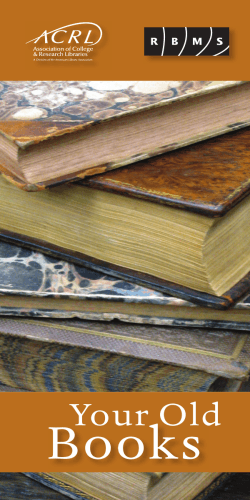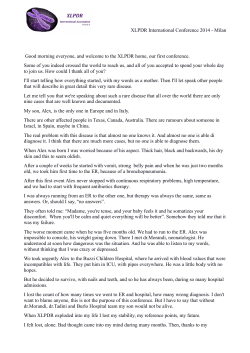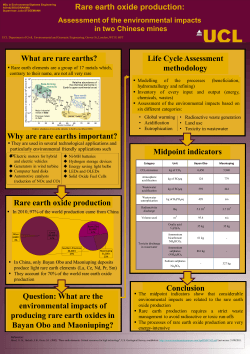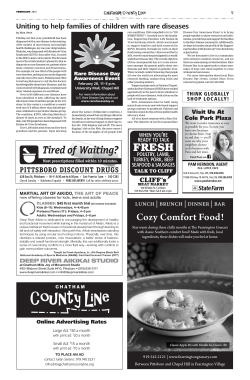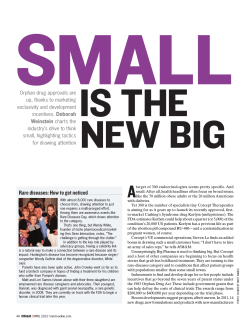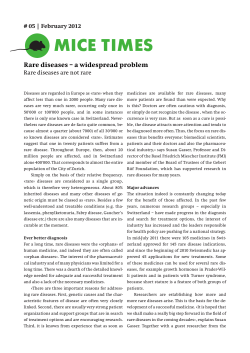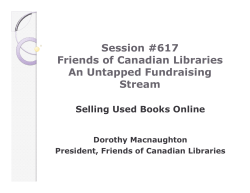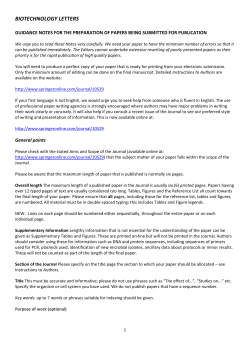
People value books either because ... their contents or because of their physi-
Your Old Books • A guide sponsored by the Rare Books and Manuscripts Section of the Association of College and Research Libraries, the Antiquarian Booksellers’ Association of America, and the Rare Book School at the University of Virginia • This guide addresses some frequently asked questions about rare and older books and their values. The answers are meant only as general responses to these questions, and many possible exceptions are not described. No attempt has been made to identify or to evaluate individual books, nor does RBMS have the resources to respond to such requests. The online appendix to this document lists other resources for more information on the questions covered. A version of this document with links to additional resources and information is available at http://www.rbms.info/yob. shtml. Questions covered: 1. What makes a book rare? 2. What makes a book important? 3. Does scarcity increase a book’s value? 4. Are all old books valuable? 5. What is the difference between a rare book and a second-hand book? 6. What is meant by a book’s condition, and how does that affect a book’s value? 7. Where are rare books found? 8. What kinds of books are usually not rare? 9. What is the difference between a first and a limited edition? 10. Is a book signed or marked up by a previous owner, or autographed by the author, more valuable? 1 11. Are old letters, scrapbooks, photographs, and documents valuable? 12. Might someone want my single volume to complete a set? 13. How can I keep my books in good condition? 14. Should I have my books rebound? 15. Do I need to insure my books? 16. How do I describe my books? 17. Should I have my books appraised? 18. Where can I find an appraiser? 19. How can I sell my books? 20. How can I ascertain a fair price? 21. Can I sell or give my old books to a library? 22. Who else might accept my old books as a donation? 23. Where can I go for more information on old and rare books, book collecting, and evaluating books? 1. What makes a book rare? Millions of books, pamphlets, magazines, newspapers, and broadsides have been published since the invention of printing more than five hundred years ago. Only a small portion of these pieces, however, would be considered “rare” by specialists. In simple terms, books achieve a degree of rarity only when demand exceeds supply. Unfortunately, there are no easy formulas for determining rarity. 2. What makes a book important? People value books either because of their contents or because of their physical characteristics. First editions of important literary or historical works and initial reports of scientific discoveries or inventions are prime examples of books that are important because of their contents. Illustrated books that give a new interpretation of a text or are the work of an esteemed artist are also valued. Books that were suppressed or censored may be both important and scarce, since few copies may have survived. Physical characteristics, such as a special binding, an early use of a new printing process, or an autograph, inscription, or marginal annotations of a famous person, may also contribute to a book’s importance and its market price. 3. Does scarcity increase a book’s value? A book known to exist in only a few copies may have significant monetary value if collectors and libraries prize it. Searching the Internet using services like abaa.org, addall.com, or vialibri.com can give you an idea of how many copies of a book are currently being offered for sale. For information about how many copies are held by libraries, your local librarian can help you access databases such as OCLC’s WorldCat. Regardless of scarcity, a book without important text or distinguishing physical characteristics is likely to have little market value. 4. Are all old books valuable? Age by itself is not enough to make a book valuable. The importance of the text, the condition of the book, and demand for it will determine the valuation of an old book. However, certain categories of books are generally more sought after, including all books printed before 1501, English books printed before 1641, books printed in the Americas before 1801, and books printed west of the Mississippi before 1850. 5. What is the difference between a rare book and a second-hand book? A second-hand or used book is a previously owned book that is neither an important edition nor has special physical characteristics, such as binding, inscription, or association with important previous owners. Market prices for secondhand books are typically modest. 6. What is meant by a book’s condition, and how does that affect a book’s value? Condition refers to a book’s physical appearance and the completeness of its contents. In general, the better a book’s physical condition, the more it will be worth. Terms that might be used to describe old books include (from best condition to worst condition) “As New,” “Fine” (no defects), “Very Good,” “Good,” “Fair” (worn but includes complete text), and “Poor” (very worn, but readable). Missing or mutilated covers, pages, or illustrations must be noted and are major faults that will severely compromise the book’s value. 7. Where are rare books found? Because books are portable and durable, rare books can turn up anywhere, from well-ordered private libraries to attics, basements, garage sales, and increasingly on Internet bookseller and auction sites. Books considered rare by collectors and librarians may be found together with more common books. Experience and 2 specialized knowledge are often needed to discriminate among them. 8. What kinds of books are usually not rare? Bibles No single work has been printed more often than the Bible. Because they are so common, most Bibles have no significant monetary value. Certain important editions of the Bible, however, are collectable: the earliest printed Bibles dating from the fifteenth and sixteenth centuries; the 1611 printings of the first authorized English (King James) version; and a variety of sixteenth- and seventeenthcentury oddities such as the “Breeches” Bible, the “Vinegar” Bible, and the “Wicked” Bible, which have some misprint or peculiar wording. Most Bibles that contain handwritten genealogical or other family information do not have market value, unless the families or individuals were famous. Sermons and R eligious Instruction Like Bibles, many other types of religious books, such as hymnals and other worship books, collections of sermons, and books of religious instruction were intended for wide circulation. Great quantities were printed as cheaply as possible, making them both less scarce and less attractive to collectors. There are some exceptions. Early Shaker tracts, for example, are considered important and may be quite rare, resulting in greater demand and higher prices. 3 C ollected E ditions of an Au thor’s Work When authors become popular and well established, publishers often issue collected editions of their works. Such editions may be offered in special bindings and may even be limited and signed, but they are seldom rare. Exceptions include editions published by fine presses or those with historically significant editors, which may be valued by collectors or libraries for that reason. E ncycl opedias Since encyclopedias are published and purchased for the currency of their information, obsolete editions of modern encyclopedias have little monetary value, whatever the historical interest of their articles. The eleventh edition (1911) of the Encyclopædia Britannica may be one exception. Complete sets of encyclopedias published before 1800 also have some market value, and single volumes proportionately less. Textb o oks Old schoolbooks and college textbooks fall into the category of second-hand books with a few exceptions. There is a market for early American primers (for example, the Eclectic Reader of William Holmes McGuffey), although prices vary considerably depending on the edition and condition. Illustrated textbooks printed before 1850 are also sought after, as are early examples that instructed students about topics now studied, such as the place of African Americans, women, or immigrant groups in society. R eprints and Facsimiles Reprinting important texts in typographic or photographic facsimile is a common and inexpensive means of producing a previously printed text. Such facsimiles are generally not rare and are valued as used books. Extremely highquality reproductions of medieval and Renaissance manuscripts and early printed books, however, can be quite expensive. Color facsimiles published during the nineteenth century are also valued by collectors when they were produced using innovative printing techniques such as collotype or chromolithography. 9. What is the difference between a first and a limited edition? An “edition” of a work is the total number of copies of a book printed from the same setting of type (be it metal type, phototype, or by digital means). If a book proves popular, the edition may be reprinted from the same setting of type, with no or minimal changes. This is generally known as a “printing.” Information about editions and printings is sometimes included on the title page of a book or on the back (verso) of the title page. If no information is provided, determining the edition or printing usually requires research using specialized bibliographies. Intensive collecting of true “first editions” of important modern literary works over the past few decades has substantially raised the market value of copies in fine condition. The term “limited edition” is reserved for editions in which copies contain an explicit “limitation statement,” usually on the back of the title page or on a separate page at the beginning or end of the volume. The limitation statement gives the total number of copies, sometimes with a breakdown of how many copies were printed on a certain type of paper, or bound in a certain kind of binding, or reserved or withheld from sale. The number of the specific copy is often printed or added by hand (as in “no. 46 of 500”), sometimes with the autograph of the author(s), publisher, or other contributor. The size of an edition, whether explicitly limited or not, does not by itself determine a book’s rarity or value. 10. Is a book signed or marked up by a previous owner, or autographed by the author, more valuable? The association of a book with a previous owner can add to its value, if that person is important or famous. Autographs, inscriptions or dedications, manuscript annotations, bookplates or stamps, or other distinctive markings may all be forged, so they need to be authenticated before a positive statement of association can be made. Contemporary authors routinely sign many copies of their books at publicity events organized to promote sales. Because they are common, such autographs typically add little to the market value of the book. Authors also sign books on other occasions, and they sometimes inscribe and present them to important associates and friends. Such “presentation” or “association” copies may command a premium. Expert knowledge of the current market is needed in order to determine the value of a particular signed or inscribed copy. 4 11. Are old letters, scrapbooks, photographs, and documents valuable? Collectors and librarians often compete for the letters, cards, documents, photographs, and manuscripts of famous people, creating a market for them. The market value of such materials, like that of printed books, depends on perceived importance and condition, scarcity of comparable material, and actual condition. Similar materials created by people who are not famous may be of interest to librarians if they document a particular place, era, or segment of society. For more information, you might consult the Guide to Donating Your Personal or Family Papers to a Repository on the Society of American Archivists Web site, http://www.archivists.org/publications/ donating-familyrecs.asp. 12. Might someone want my single volume to complete a set? Because the chance of finding a buyer with a set lacking the exact volume or volumes is remote, single volumes or incomplete sets of multivolume works generally have little appeal to booksellers, collectors, or librarians. Exceptions include books considered rare because of their age and scarce early volumes of magazines or newspapers. 13. How can I keep my books in good condition? Books are damaged by light and by fluctuations and extremes in temperature and humidity. It is best to store them in a cool, comfortably dry, stable environment with low or indirect lighting. Most basements, garages, and attics are too hot, too damp, or too variable to provide good storage conditions. Avoid shelving 5 books where they will be exposed to direct sunlight. Do not wrap books in newspaper or plastic or store them in cardboard boxes. Acid in the cardboard and in newsprint will damage books. Plastic wrappers, because they restrict air circulation, can promote the growth of mold or mildew. Furthermore, some plastics degrade over time and fuse to the materials they are touching. Store large books, such as atlases, bound newspapers, or art folios, flat on shelves rather than standing vertically. Never use adhesive tape to repair torn pages or a binding because it yellows with age and leaves a nasty residue. You can buy various types of protective enclosures for storing older or fragile books. See question fourteen below, and the Web site appendix, for suggestions on further reading and contact information for distributors of archival supplies. 14. Should I have my books rebound? It is best to consult an expert before rebinding. Rebinding can lessen the value of some books, and in other cases, the cost of the work will greatly exceed the monetary value of the book. Conservators will often recommend a less drastic approach. Properly fitted boxes or wrappers can often be alternatives to repairing or replacing the binding and can help to preserve the item in its original form. For further advice on conservation treatments, please consult the American Institute of Conservation’s Guidelines for Selecting a Conservator at http://aic.stanford.edu/public/select.html. 15. Do I need to insure my books? Most homeowner’s and renter’s insurance policies cover the loss of books, like other household items. If you own valuable books, consult with your agent to be sure they are adequately covered. Make a list of your books, and store it in a safe place so that you will have a record in case of theft, loss, or damage. Your agent may also suggest that you have your books professionally appraised to document their replacement value. 16. How do I describe my books? That depends on your purpose in listing your books and the kind of books you own. For insurance purposes or in order to sell your books, digital photographs of the binding and dust jacket (if any), as well as the title page and any other publication information, will be helpful. If you cannot provide photographs, you should make a complete transcription of the main title page and any other publication information given at the beginning or end of the volume, as well as a description of its binding, indicating wear or damage, and other physical features. deciding whether you need to have your books appraised is whether your collection is worth enough to warrant the expense. An experienced appraiser should be able to give you an estimate of the cost in advance if you provide an adequate preliminary description of your books. Other documentation can be used to establish the value of your books. If you bought them, you can use your invoices or receipts. If you inherited them, any legal or fiscal documents that describe the transfer of property may contain information about their value. If you wish to take a tax deduction for donating them, and their combined value is less than $5,000, such documentation and/ or copies of recent sale records of comparable items may be sufficient evidence. Donations of books with a value exceeding $5,000 require professional appraisal. Consult the freely downloadable IRS Publication 561 entitled Determining the Value of Donated Property or a tax advisor for details. 17. Should I have my books appraised? A professional appraisal of your books is the surest way to establish their value for the purpose of insuring them, preparing them for sale, or reporting their donation as a charitable tax deduction. However, appraisals can be expensive and are often unnecessary. Qualified appraisers are experts in their areas of specialty and charge hourly fees for their labor. An appraiser will need to inspect your books personally and then research his or her findings in specialized bibliographies and published sale records in order to determine values. Depending on the size of your collection, this may require many billable hours. Thus, one factor in 18. Where can I find an appraiser? Many booksellers perform appraisals as part of their business. The Antiquarian Booksellers’ Association of America has a membership directory on its Web site (http://www.abaa.org) that allows you to search for qualified booksellers by geographical region or by their fields of specialty. Your local yellow pages directory may also contain the names of “used,” “rare,” or “antiquarian” booksellers in your area. Because the range of rare books is vast, you should seek an appraiser who is knowledgeable about the particular type of books you have. Ask for references and referrals until you are satisfied that you have found the right person. Other 6 sources for finding appraisers include the Appraisers Association of America and the International Society of Appraisers. 19. How can I sell my books? You can sell your books to a bookseller, through a professional auction house, or on your own through an online auction or other means of direct sale. Which is best for you will depend on the rarity and value of your books, your location, how quickly you need to sell them, and the time you are willing to spend marketing them. If you simply have a few secondhand books to clear off your shelves, a good option will be to find a local used book shop willing to buy the lot from you. If your books are rare or valuable, then finding a bookseller that specializes in the particular kind of books you have may be your best option. Directories published on the Web by the Antiquarian Booksellers’ Association of America or the International League of Antiquarian Booksellers can help identify qualified merchants. If the first dealer you contact cannot help you, ask for a referral. Many individuals who wish to sell their books are unsure of their worth and so must depend to a great extent on the trustworthiness and professional behavior of the dealer. Booksellers who are members of the Antiquarian Booksellers’ Association of America or the International League of Antiquarian Booksellers must abide by a strict code of ethics designed to protect their customers. When selecting booksellers with whom to do business, ask whether they belong to these organizations or have other verifiable credentials attesting to their integrity. If you decide to sell your books to a bookseller, keep in mind that it costs booksellers money to run their businesses. In order to cover their overhead costs and turn a fair profit, they must offer you less for your books than they will sell them for—often a good deal less. If you decide to sell your books yourself through an auction service, setting a reserve limit will ensure that you do not have to accept a bid for less than a certain minimum amount. 20. How can I ascertain a fair price? Many booksellers now have searchable catalogs and databases on the World Wide Web. These resources can be very helpful in determining an approximate retail value of your books because they can be used to find recent prices asked for similar copies. When comparing your book to a description in such a database, be careful to find as close a match as possible, not only in terms of publication details, but also in terms of condition, binding, and other unique features. You can also search some auction sites to find prices realized in recent sales. 21. Can I sell or give my old books to a library? All libraries buy books, but they generally find the administrative overhead involved in buying from private individuals costly and difficult, and thus may refuse your offer on that basis alone. If the library is willing to consider buying a book from you, be prepared to provide a full description and state a reasonable price. Libraries will welcome donations if the donated books fit their collection profile. Most public libraries focus on popular publications that circulate frequently. 7 Many academic and research libraries are interested in acquiring rare and unique materials. School libraries, especially in impoverished areas, may welcome donations of used or older books. If the item does not fit its collection profile, the library may refuse the gift. Most libraries will also refuse donations that include restrictions on the use or disposition of the donated books. 22. Who else might accept my old books as a donation? Many organizations welcome donations of second-hand or used books, either because it is part of their mission to provide reading materials to others, or because they can sell them to raise money to support charitable causes. Goodwill, Oxfam, the Salvation Army, churches, synagogues, and other charitable institutions will welcome your donated books. 23. Where can I go for more information on old and rare books, book collecting, and evaluating books? The Web version of this document, which is available at http://www.rbms. info/yob.shtml, includes links to additional resources and information. The Web site of the Antiquarian Booksellers’ Association of America (ABAA) (http:// abaa.org) also features a variety of helpful information for book collectors, such as a glossary of terms, a list of frequently asked questions, resources on book collecting, and a searchable directory of ABAA member booksellers. Sp on s or s of T h i s P ub l i c at i on 8
© Copyright 2025
